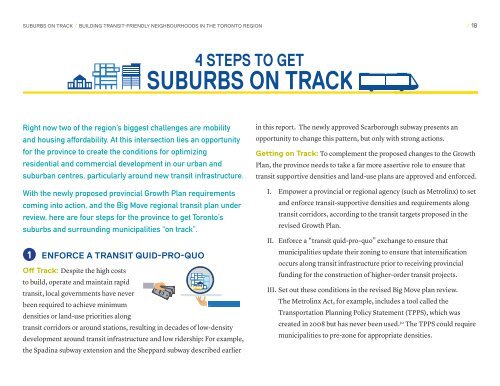SUBURBS ON TRACK
9oHn303Zgxi
9oHn303Zgxi
You also want an ePaper? Increase the reach of your titles
YUMPU automatically turns print PDFs into web optimized ePapers that Google loves.
<strong>SUBURBS</strong> <strong>ON</strong> <strong>TRACK</strong> / BUILDING TRANSIT-FRIENDLY NEIGHBOURHOODS IN THE TOR<strong>ON</strong>TO REGI<strong>ON</strong> / 18<br />
4 STEPS TO GET<br />
<strong>SUBURBS</strong> <strong>ON</strong> <strong>TRACK</strong><br />
Right now two of the region’s biggest challenges are mobility<br />
and housing affordability. At this intersection lies an opportunity<br />
for the province to create the conditions for optimizing<br />
residential and commercial development in our urban and<br />
suburban centres, particularly around new transit infrastructure.<br />
With the newly proposed provincial Growth Plan requirements<br />
coming into action, and the Big Move regional transit plan under<br />
review, here are four steps for the province to get Toronto’s<br />
suburbs and surrounding municipalities “on track”.<br />
1 ENFORCE A TRANSIT QUID-PRO-QUO<br />
Off Track: Despite the high costs<br />
to build, operate and maintain rapid<br />
transit, local governments have never<br />
been required to achieve minimum<br />
densities or land-use priorities along<br />
transit corridors or around stations, resulting in decades of low-density<br />
development around transit infrastructure and low ridership: For example,<br />
the Spadina subway extension and the Sheppard subway described earlier<br />
in this report. The newly approved Scarborough subway presents an<br />
opportunity to change this pattern, but only with strong actions.<br />
Getting on Track: To complement the proposed changes to the Growth<br />
Plan, the province needs to take a far more assertive role to ensure that<br />
transit supportive densities and land-use plans are approved and enforced.<br />
I. Empower a provincial or regional agency (such as Metrolinx) to set<br />
and enforce transit-supportive densities and requirements along<br />
transit corridors, according to the transit targets proposed in the<br />
revised Growth Plan.<br />
II. Enforce a “transit quid-pro-quo” exchange to ensure that<br />
municipalities update their zoning to ensure that intensification<br />
occurs along transit infrastructure prior to receiving provincial<br />
funding for the construction of higher-order transit projects.<br />
III. Set out these conditions in the revised Big Move plan review.<br />
The Metrolinx Act, for example, includes a tool called the<br />
Transportation Planning Policy Statement (TPPS), which was<br />
created in 2008 but has never been used. 30 The TPPS could require<br />
municipalities to pre-zone for appropriate densities.<br />
$<br />
TOOL BOX


